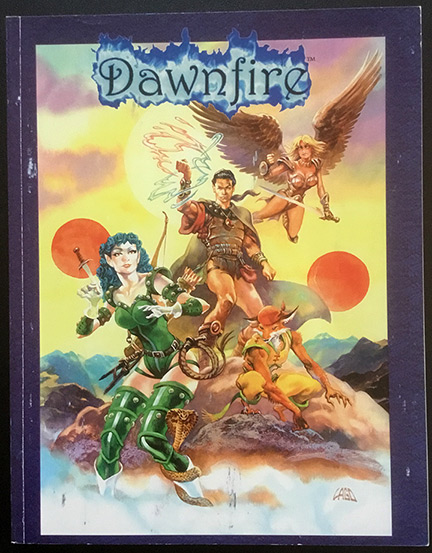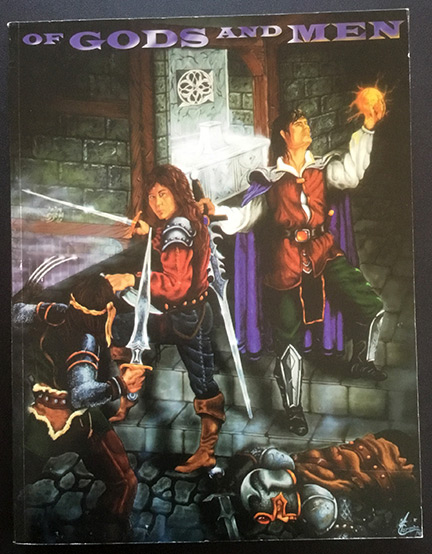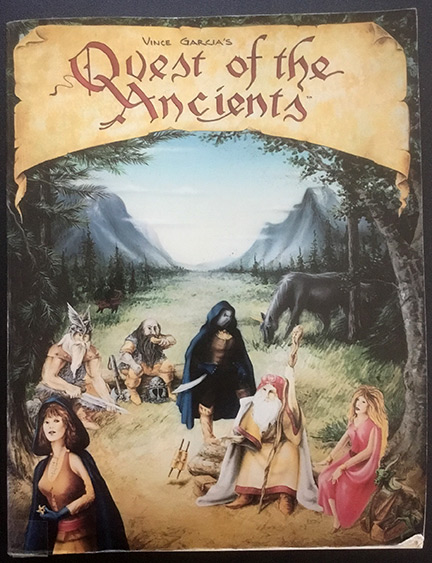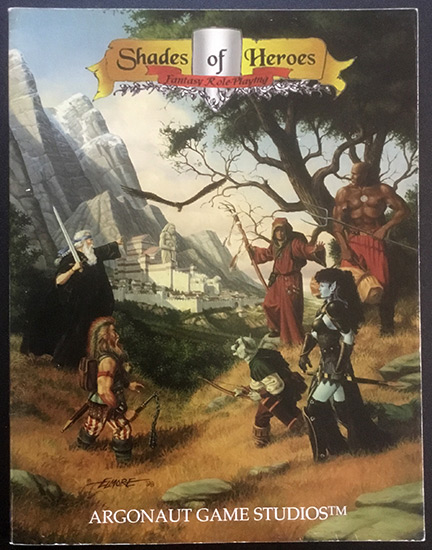|
 |
|
This blog entry marks the first in a series discussing forgotten RPGs. When I write forgotten, I mean games that most people never heard of or that didn't last long on store shelves for one reason or another. This batch consists of fantasy games. These games have been sitting on my shelf for years, mostly ebay finds to add to my collection.


1. Dawnfire (by Jason Marin; published by Dawnfire Games / Committed Comics in 2000)

This game is unique, as I can't remember seeing another share its one odd characteristic, that of being printed on what feels like newsprint. You know, that really thin newspaper paper. It's got 12 core races, including winged humanoids and 3 types of Elves. Then are are 6 types of optional races, including a second type of minotaur and dwarf, another elf, and shape changers. Statistics consist of 3 physical (strength, agility, and endurance), 3 mental (IQ, common sense, and perception), and 3 social (presence, manipulation, and luck). Then there is a focus: either warrior, rogue, or shaper (magic-user). A basic skill roll is made with a d20. Rolling under the skill level (+ statistic modifier) is a success. Combat is similar, rolling under a base of 10 (+modifiers). The book deals with skills, magic, monsters, skill lists, and experience. Some of the art is really good, but most is either OK or weak. While the system seems fairly simple, I'm put off by all the modifiers for statistics and skills (sort of like attribute modifiers for D&D). Not a bad attempt for the 80s, but I would expect more from a 2000 release.

EDIT: Two other games used newsprint: the original Mechanoid Invasion by Palladium Games and DC Heroes by West End Games.




2. GateWar (by Ken Burridge; published by Escape Ventures in 1994)

This is the third edition of what was originally called Element Masters. I don't have that book, but I've seen it appear on eBay numerous times. The layout is crisp and easy to read. The game takes place on the world of Vinya. While it is a fantasy game in principle, alien races are present due to the opening of a gateway between worlds. There are 7 races, with some mimicking traditional fantasy races. Lots of charts in this game for determining random elements. There are 8 characteristics: strength, size, constitution, dexterity, intelligence, magic point total, appearance, and luck. There are secondary characteristics derived from the main ones. Other factors like materialism, interests, handedness, and mental quirks also help define characters. There are lots of professions that may provide some benefits, but also determine a daily wage. Tasks are performed with percentage rolls based on a character's skill. Raw feats of ability (using only a characteristic) are done by assigning a difficulty, determining the difference between the difficulty and character's score, and adjusting a base 50% chance by ±5% x difference (sort of like Man, Myth & Magic in this regard). Did I mention that there are lots of tables? Lots of tables with lists of numbers. There are some interesting rules for combat like blood loss, but attack rolls seem to rely on combat skills -- it's rather confusing. The creatures section is massive and some of them are really interesting. I can see borrowing these for other games you may be running. In fact, the setting could easily be integrated with Exiled in Eris. I'm not sure what to think of this game. I actually like it, but I would revert to another system for ease of use.




3. Of Gods and Men (by Jeffrey Konkol; published by Non Sequitur Productions in 1991)

Since the character sheet appears on the third page, I'm going to start with that. There are 6 primary abilities: strength, dexterity, health, influence, knowledge, and will. No luck this time. Secondary values include body points, dodge points, energy, power, movement, and encumbrance. Rather than having various races as in most other fantasy games, this one focuses on (human) cultures. And each one has a different skill list with different calculated values. Combat seems a bit odd to me: percentage chance to hit is skill level ± modifiers - protection, but 86+ automatically misses -- then the defender can also choose to parry at his skill level. Everything else in the game seems pretty well fleshed out, and there are some interesting creatures. 54 divine power cards are inserted in the book to be separated and given to players when the GM thinks it appropriate -- this is a unique feature, but can be easily done with a chart. Not a bad game, but it is somewhat confusing to me. Still, nowhere near as many charts and tables as in GateWar.

EDIT: It seems that this game is still around in PDF format (Link).




4. Quest of the Ancients (by Vince Garcia; published by Unicorn Game Publications in 1988?)

The first thing I see upon opening the book is a transparency with something called the spell circle, which is used to determine the area of effect when using miniatures. Not what I would expect to find in this book, but let's see what else there is (it's been a while since I've opened this book). The layout has an Amber RPG feel to it. There's a page with a bunch of tables before chapter one, containing info about race stat modifiers, modifiers for certain magical rolls involving monsters, how to determine armor rating based on materials and agility, and stat adjustments for amor, damage, skills, and attack. There are 9 stats: strength, agility, conditioning, IQ, charm, appearance, luck, stamina, and body (average of strength and conditioning). There are lots of tables for the stats akin to D&D. The typical races are present, with various professions in place of classes, even though they use levels that are gained with level points, and unlock special abilities and bonuses. There are multiple types of fighters: cossack, gladiator, knight, legionnaire, rogue, saracen, viking, and woodsman. Same with tricksters: assassin, bard, cutpurse, and gypsy. Then spellcasters: druid, earth priest, necromancer, sorcerer, and witch. All the relevant spells are listed with each profession, so we're up to page 157 out of 216. Skills are on pages 158-160, telling me that you get IQx10 points to buy skill percentages, but not all are at a 1:1 ratio. Then equipment. Then a few pages for adventure concepts. Finally, combat on page 173. Anyone have a d30 to roll? Base to hit is 22 or less at AR 5(+2), plus modifiers. Easy enough, but the part explaining how to modify the roll based on armor rating is very confusing. I gave up worrying about it after 10 minutes. I turned the page to find a bunch of long tables that tell me to forget those armor calculations as I can just look them up (sort of like D&D to-hit tables, but longerrr (3 double-column pages). Pages 182-186 tell us how to use all those handy spells. We've got some rewards (treasures) and then a basic map and a bunch of monsters. I probably could have cut this down to half the size. Seriously, other than hardcore old-school and DCC gamers, does anyone have a d30?




4. Shades of Heroes (by Jason "Kurbs" Kirby; published by Argonaut Game Studios in 1998)

First impression: the layout is reminiscent of stuff I've seen within the last 10 years. Not a good or a bad thing, just how I picture it. We've got the three basic in fantasy races (humans, dwarves, and elves) plus Ferlings (short, furry things), Obdrons (tall, muscular, and mostly hairless), and Wolcs (shape-shifters). There are 6 attributes that range from -5 to 10: strength, agility, fortitude, intelligence, perception, and charisma. That's a pretty solid and efficient spread. There are some derived attributes, of course: life points, hit points, initiative, speed, action points, mana, hit rating, defense, damage bonus, and carry. We get a bunch of skills too. The weapon and armor art is my favorite art in the book. I thought the attribute rating may have a direct effect on rolls, but I was wrong. They merely determine those derived attributes and then tell you what sort of die combination to roll. For example a rating of 2 is 1d10, while a rating of 10 is 1d20 + 1d6. Looks like I'm wrong. You actually roll dice determined by the difficulty (hard or 7 is 1d10+1d3), rolling over the relevant attribute score. Perhaps the attribute dice are for opposing rolls. Turns out the derived hit rating is used to determine what dice combination to roll for attack. Huh! Spells, treasure, and the usual assortment of monsters finish the book.




5. The Essential Fantasy Earth (by Michael C. Zody; published by Zody Games in 1996)

Set in Helvetica. Let's see what this is about. It says to assign certain values to 10 different abilities: strength, endurance, agility, speed, manipulation, perception, intelligence, mental strength, power, and charisma. That's a lot for a game with skills. There are 4 classes: warriors, burglars, rangers, and sorcerers (each with its own skill list). Fooled again. I thought this 1-10 scale might have a direct correlation to rolls. Nope. Modifiers. So, we roll 1d10 + skill level ± ability modifier (-4 to +4) to beat a difficulty number (similar scale as modern D&D). Easy. Combat is different. Roll 2d10 + same as before + weapon modifiers - injury penalties, etc. against a difficulty of 16 for melee. Ranged combat determines the modifiers differently by doubling some of them -- and difficulty depends on range. I don't know. I gave up again. Then the defender can parry vs. difficulty of 18. Did I miss something again? Why 2d10 instead of 1d10? Spells and basic setting round out the rest of the book, as it's meant to be a basic guide (this is like the basic version). It's got the makings of a new millennium game, but doesn't quite get over the hurdle by being trapped in inconsistencies (I get a sense of a MasterBook-like approach at times). This is the shortest of the group, at only 78 pages.




That's it for now. If I had to recommend one, it would probably be GateWar to mine for ideas.


Part 2... | | 4 Comments | Add Comment | Permanent Link | See All Posts Tagged as "ForgottenGames" | | Return to Overview | | Narmer Commented: | Sep 22, 2020 | 6:02 pm | |
| Brett Commented: | Sep 22, 2020 | 6:06 pm | |
| MrTim Commented: | Nov 06, 2020 | 1:42 pm | |
| Brett Commented: | Nov 06, 2020 | 1:47 pm | |
Add Comment |
 |
|
|
|
|







